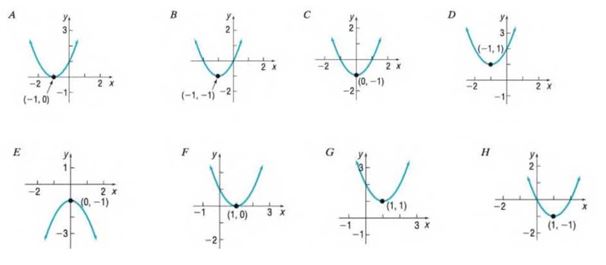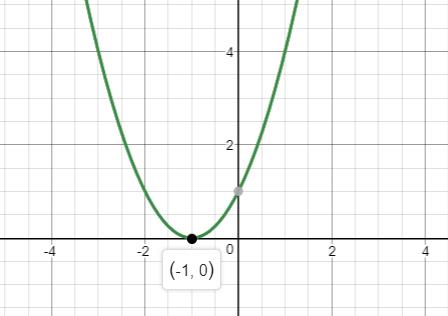Problem 1AYU: List the intercepts of the equation y= x 2 9 . (pp. 18-19) Problem 2AYU Problem 3AYU: To complete the square of x 2 5x , you add the number ______. (p. A49) Problem 4AYU: To graph y= (x4) 2 you shift the graph of y= x 2 to the _______ a distance of ________ units. (pp.... Problem 5AYU: The graph of a quadratic function is called a(n) ____________. Problem 6AYU: The vertical line passing through the vertex of a parabola is called the ________________. Problem 7AYU: The x-coordinate of the vertex of f( x )=a x 2 +bx+c,a0 , is ______. Problem 8AYU: True or False The graph of f( x )=2 x 2 +3x4 opens up. Problem 9AYU: True or False The y-coordinate of the vertex of f( x )= x 2 +4x+5 is f( 2 ) . Problem 10AYU: True or False If the discriminant b 2 4ac=0 , the graph of f( x )=a x 2 +bx+c,a0 , will touch the... Problem 11AYU: In Problems 13-20, match each graph to one the following functions. f( x )= x 2 1 Problem 12AYU: In Problems 13-20, match each graph to one the following functions. f(x)= x 2 1 Problem 13AYU: In Problems 13-20, match each graph to one the following functions. f(x)= x 2 2x+1 Problem 14AYU: In Problems 13-20, match each graph to one the following functions. f( x )= x 2 +2x+1 Problem 15AYU: In Problems 13-20, match each graph to one the following functions. f( x )= x 2 2x+2 Problem 16AYU: In Problems 13-20, match each graph to one the following functions. f( x )= x 2 +2x Problem 17AYU: In Problems 13-20, match each graph to one the following functions. f( x )= x 2 2x Problem 18AYU: In Problems 13-20, match each graph to one the following functions. f( x )= x 2 +2x+2 Problem 19AYU: In Problems 21-32, graph the function f by starting with the graph of y= x 2 and using... Problem 20AYU: In Problems 21-32, graph the function f by starting with the graph of y= x 2 and using... Problem 21AYU: In Problems 21-32, graph the function f by starting with the graph of y= x 2 and using... Problem 22AYU: In Problems 21-32, graph the function f by starting with the graph of y= x 2 and using... Problem 23AYU: In Problems 21-32, graph the function f by starting with the graph of y= x 2 and using... Problem 24AYU: In Problems 21-32, graph the function f by starting with the graph of y= x 2 and using... Problem 25AYU: In Problems 21-32, graph the function f by starting with the graph of y= x 2 and using... Problem 26AYU: In Problems 21-32, graph the function f by starting with the graph of y= x 2 and using... Problem 27AYU: In Problems 21-32, graph the function f by starting with the graph of y= x 2 and using... Problem 28AYU: In Problems 21-32, graph the function f by starting with the graph of y= x 2 and using... Problem 29AYU: In Problems 21-32, graph the function f by starting with the graph of y= x 2 and using... Problem 30AYU: In Problems 21-32, graph the function f by starting with the graph of y= x 2 and using... Problem 31AYU: In Problems 33-48, (a) graph each quadratic function by determining whether it graph opens up or... Problem 32AYU: In Problems 33-48, (a) graph each quadratic function by determining whether it graph opens up or... Problem 33AYU: In Problems 33-48, (a) graph each quadratic function by determining whether it graph opens up or... Problem 34AYU: In Problems 33-48, (a) graph each quadratic function by determining whether it graph opens up or... Problem 35AYU: In Problems 33-48, (a) graph each quadratic function by determining whether it graph opens up or... Problem 36AYU: In Problems 33-48, (a) graph each quadratic function by determining whether it graph opens up or... Problem 37AYU: In Problems 33-48, (a) graph each quadratic function by determining whether it graph opens up or... Problem 38AYU: In Problems 33-48, (a) graph each quadratic function by determining whether it graph opens up or... Problem 39AYU: In Problems 33-48, (a) graph each quadratic function by determining whether Us graph opens up or... Problem 40AYU: In Problems 33-48, (a) graph each quadratic function by determining whether Us graph opens up or... Problem 41AYU: In Problems 33-48, (a) graph each quadratic function by determining whether Us graph opens up or... Problem 42AYU: In Problems 33-48, (a) graph each quadratic function by determining whether Us graph opens up or... Problem 43AYU: In Problems 33-48, (a) graph each quadratic function by determining whether Us graph opens up or... Problem 44AYU: In Problems 33-48, (a) graph each quadratic function by determining whether Us graph opens up or... Problem 45AYU: In Problems 33-48, (a) graph each quadratic function by determining whether Us graph opens up or... Problem 46AYU: In Problems 33-48, (a) graph each quadratic function by determining whether Us graph opens up or... Problem 47AYU: In Problems 49-54, determine the quadratic function whose graph is given. Problem 48AYU: In Problems 49-54, determine the quadratic function whose graph is given. Problem 49AYU: In Problems 49-54, determine the quadratic function whose graph is given. Problem 50AYU: In Problems 49-54, determine the quadratic function whose graph is given. Problem 51AYU: In Problems 49-54, determine the quadratic function whose graph is given. Problem 52AYU: In Problems 49-54, determine the quadratic function whose graph is given. Problem 53AYU: In Problems 6572, determine, without graphing, whether the given quadratic function has a maximum... Problem 54AYU: In Problems 55-62, determine, without graphing, whether the given quadratic function has a maximum... Problem 55AYU: In Problems 55-62, determine, without graphing, whether the given quadratic function has a maximum... Problem 56AYU: In Problems 55-62, determine, without graphing, whether the given quadratic function has a maximum... Problem 57AYU: In Problems, determine, without graphing, whether the given quadratic function has a maximum value... Problem 58AYU: In Problems 55-62, determine, without graphing, whether the given quadratic function has a maximum... Problem 59AYU: In Problems, determine, without graphing, whether the given quadratic function has a maximum value... Problem 60AYU: In Problems 55-62, determine, without graphing, whether the given quadratic function has a maximum... Problem 61AYU: The graph of the function f( x )=a x 2 +bx+c has vertex at ( 0,2 ) and passes through the point (... Problem 62AYU: The graph of the function f(x)=a x 2 +bx+c has vertex at ( 1,4 ) and passes through the point (1,8)... Problem 63AYU: In Problems 77-82, for the given functions fandg , (a) Graph fandg on the same Cartesian plane. (b)... Problem 64AYU: In Problems 77-82, for the given functions fandg , (a) Graph fandg on the same Cartesian plane. (b)... Problem 65AYU: In Problems 77-82, for the given functions fandg , (a) Graph fandg on the same Cartesian plane. (b)... Problem 66AYU: In Problems 77-82, for the given functions fandg , (a) Graph fandg on the same Cartesian plane. (b)... Problem 67AYU: In Problems 77-82, for the given functions fandg , (a) Graph fandg on the same Cartesian plane. (b)... Problem 68AYU: In Problems 77-82, for the given functions fandg , (a) Graph fandg on the same Cartesian plane. (b)... Problem 69AYU: Answer Problems 83 and 84 using the following: A quadratic function of the form f( x )=a x 2 +bx+c... Problem 70AYU: Answer Problems 83 and 84 using the following: A quadratic function of the form f( x )=a x 2 +bx+c... Problem 71AYU: Suppose that f(x)= x 2 +4x21 . (a) What is the vertex of f ? (b) What are the x-intercepts of the... Problem 72AYU: Suppose that f( x )= x 2 +2x8 . (a) What is the vertex of f ? (b) What are the x-intercepts of the... Problem 73AYU: Analyzing the Motion of a Projectile A projectile is fired from a cliff feet above the water at an... Problem 74AYU: Analyzing the Motion of a Projectile A projectile is fired at an inclination ofto the horizontal,... Problem 75AYU: Maximizing Revenue Suppose that the manufacturer of a gas clothes dryer has found that, when the... Problem 76AYU: Maximizing Revenue A lawn mower manufacturer has found that the revenue, in dollars, from sales of... Problem 77AYU: Minimizing Marginal Cost The marginal cost of a product can be thought of as the cost of producing... Problem 78AYU: Minimizing Marginal Cost (See Problem 91.) The marginal cost C (in dollars) of manufacturing x cell... Problem 79AYU: Business The monthly revenue R achieved by selling x wristwatches is figured to be R( x )=75x0.2 x 2... Problem 80AYU: Business The daily revenue R achieved by selling x boxes of candy is figured to be R( x )=9.5x0.04 x... Problem 81AYU: Stopping Distance An accepted relationship between stopping distance d(in feet) and the speed v of a... Problem 82AYU Problem 83AYU Problem 84AYU Problem 85AYU Problem 86AYU Problem 87AYU Problem 88AYU Problem 89AYU Problem 90AYU Problem 91AYU Problem 92AYU format_list_bulleted





 Calculus: Early TranscendentalsCalculusISBN:9781285741550Author:James StewartPublisher:Cengage Learning
Calculus: Early TranscendentalsCalculusISBN:9781285741550Author:James StewartPublisher:Cengage Learning Thomas' Calculus (14th Edition)CalculusISBN:9780134438986Author:Joel R. Hass, Christopher E. Heil, Maurice D. WeirPublisher:PEARSON
Thomas' Calculus (14th Edition)CalculusISBN:9780134438986Author:Joel R. Hass, Christopher E. Heil, Maurice D. WeirPublisher:PEARSON Calculus: Early Transcendentals (3rd Edition)CalculusISBN:9780134763644Author:William L. Briggs, Lyle Cochran, Bernard Gillett, Eric SchulzPublisher:PEARSON
Calculus: Early Transcendentals (3rd Edition)CalculusISBN:9780134763644Author:William L. Briggs, Lyle Cochran, Bernard Gillett, Eric SchulzPublisher:PEARSON Calculus: Early TranscendentalsCalculusISBN:9781319050740Author:Jon Rogawski, Colin Adams, Robert FranzosaPublisher:W. H. Freeman
Calculus: Early TranscendentalsCalculusISBN:9781319050740Author:Jon Rogawski, Colin Adams, Robert FranzosaPublisher:W. H. Freeman
 Calculus: Early Transcendental FunctionsCalculusISBN:9781337552516Author:Ron Larson, Bruce H. EdwardsPublisher:Cengage Learning
Calculus: Early Transcendental FunctionsCalculusISBN:9781337552516Author:Ron Larson, Bruce H. EdwardsPublisher:Cengage Learning




